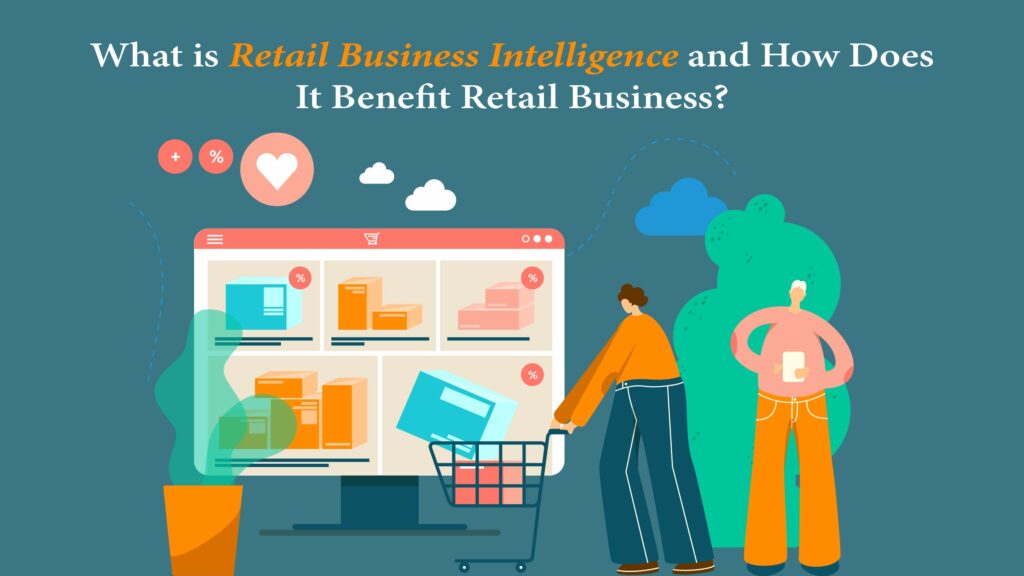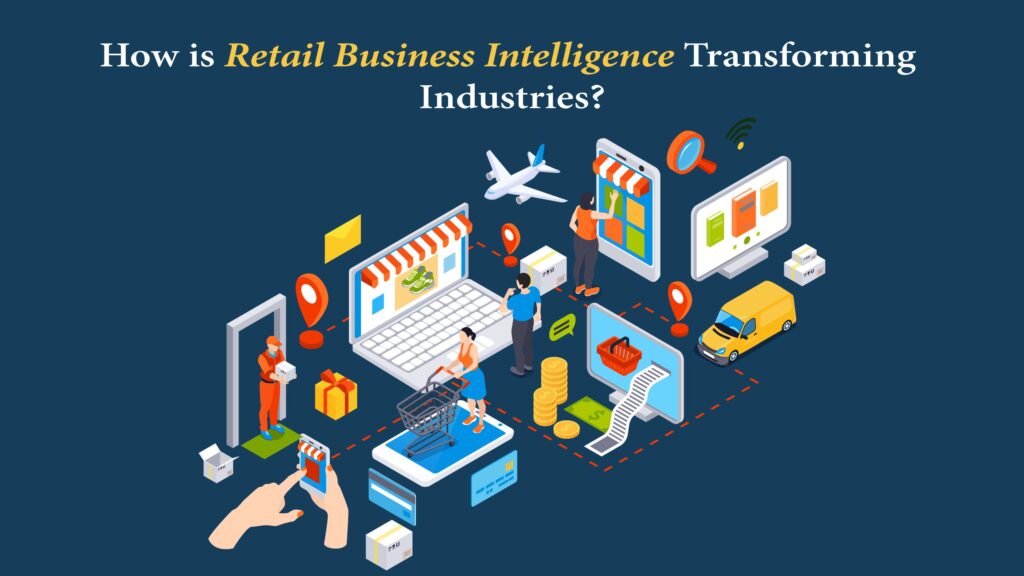Businesses often encounter significant challenges that hinder their growth and success. One such challenge is the lack of a comprehensive understanding of their customers, market trends, and operational performance. Without access to timely and accurate insights, retailers struggle to make informed decisions, resulting in inventory inefficiencies, ineffective pricing strategies, and missed growth opportunities. This is where retail business intelligence comes into play. In this article, we will see how this innovative methodology helps businesses to improve lead generation.
What is Retail Business Intelligence and How Does It Benefit Retail Business?

Retail business intelligence (RBI) encompasses the conversion of data into actionable insights within the retail sector. This involves leveraging various analytical techniques to discern trends and patterns. BI empowers retailers to optimize decisions regarding inventory, pricing strategies, marketing campaigns, and more.
Today, a plethora of BI solutions exist, including data mining, text analytics, predictive analytics, and prescriptive analytics, as well as dashboards and visualizations. Each solution offers distinct advantages, necessitating careful selection based on the unique requirements of the retailer. Maximizing the efficacy of these solutions entails identifying key metrics for tracking to derive the desired insights.
- RBI provides expanded access to valuable customer and operational data, allowing businesses to create a consistent experience across all channels and make better location-based merchandising decisions.
- RBI helps retailers optimize their inventory management by predicting when items will run out, enabling them to stay ahead of orders and avoid stockouts.
- It empowers retailers to make data-driven decisions regarding pricing strategies, marketing campaigns, and product offerings. By identifying trends and patterns through analytics, retailers can optimize pricing, target consumers on a personalized level, and offer a seamless shopping experience both online and offline.
- It plays a crucial role in cost reduction for retail businesses. By analyzing various facets of the business, such as the supply chain and marketing campaigns, retailers can identify areas where unnecessary expenses can be trimmed and streamline logistics to reduce shipping costs.
- It helps retailers stay ahead of the competition, modernize their operations, and meet the demands of the modern consumer. By leveraging the power of data and analytics, RBI enables retailers to make strategic decisions, drive growth, and maximize profitability.
What are the 4 Types of Retail Analytics?
- Descriptive Analytics: Descriptive analytics offers a comprehensive overview of past performance and historical data in the retail industry. It involves examining transactional history, changes in inventory, the effectiveness of promotions, and other key metrics. By analyzing this data, retailers gain insights into past trends and patterns, helping them understand the trajectory of their business.
- Diagnostic Analytics: Diagnostic analytics delves into the root causes behind specific outcomes or trends observed in retail operations. It addresses questions such as why sales are declining in a particular store or why customer activity fluctuates during certain periods. Through thorough data analysis and correlation identification, retailers can uncover the underlying factors influencing their business performance.
- Predictive Analytics: Predictive analytics harness historical data and statistical models to forecast future trends and outcomes within the retail sector. It enables retailers to anticipate customer behavior, predict demand patterns, and stay ahead of market trends. By leveraging predictive analytics, retailers can make proactive decisions regarding inventory management, pricing strategies, and marketing initiatives.
- Prescriptive Analytics: Prescriptive analytics takes predictive insights a step further by offering actionable recommendations for optimal decision-making. By integrating historical data, predictive models, and optimization techniques, prescriptive analytics guides retailers on the most effective courses of action to maximize profitability and operational efficiency. This advanced approach empowers retailers to fine-tune their operations, enhance decision-making processes, and achieve sustainable growth.
How is Retail Business Intelligence Transforming Industries?

Retail business intelligence is reshaping the landscape of the industry through various cutting-edge approaches.
- Earned Media Analysis: By delving into earned media analysis, e-commerce brands can strategically enhance traffic and sales without exorbitant expenditures. This method scrutinizes diverse traffic-driving channels such as social media, organic search, and email marketing. Armed with this data, retailers can craft targeted marketing strategies tailored to potential customers most inclined to make purchases.
- Product Analytics: Leveraging product analytics empowers retailers to assert control over their inventory, thus gaining a competitive edge in product-related decisions. BI analytics swiftly pinpoints top-selling products necessitating increased inventory while also identifying underperforming items ripe for discontinuation. In the realm of e-commerce, where consumer choice abounds, ensuring optimal stock levels is paramount. Product analytics coupled with robust inventory management tools enable retailers to monitor sales trends, anticipate demand, and proactively replenish stock to avoid shortages.
- Customer Analytics: Harnessing customer engagement applications enables retailers to monitor consumer interactions across various touchpoints, providing invaluable insights into customer preferences and behaviors. Real-time data collection and analysis facilitate a deeper understanding of customer needs, paving the way for enhanced customer experiences and tailored marketing efforts.
- Predictive Analytics: Predictive analytics uses machine learning to anticipate future scenarios, enabling retailers to make proactive, data-driven decisions. This entails forecasting profitable products for preemptive stocking and identifying customers at risk of churning to implement targeted retention initiatives. By harnessing the power of predictive analytics, retailers can optimize business outcomes and stay ahead of the curve in a rapidly evolving market landscape.
Also Read: 6 Top Retail Management Software for 2024
Here’s how BI is transforming retail success:
Sales and Inventory Management:
BI enables retailers to analyze historical sales data, facilitating accurate predictions of future demand. By aligning inventory levels with anticipated demand, retailers can avoid overstocking or understocking issues. This optimization ensures products are available when customers need them, minimizing losses and enhancing efficiency.
Customer Analytics:
Understanding customers is pivotal in retail, and BI tools delve deep into customer data to provide insights. Retailers leverage this information to create personalized shopping experiences, such as offering tailored product recommendations and promotions based on past purchases and browsing behavior.
Supply Chain Optimization:
A streamlined supply chain is essential for retail success, and BI tools offer real-time visibility into product movement. By identifying bottlenecks and optimizing routes, retailers enhance supply chain efficiency, reducing costs, and ensuring timely delivery to customers.
Marketing Effectiveness:
BI tools evaluate the effectiveness of marketing campaigns, enabling retailers to measure ROI across various channels. By identifying the most successful advertising channels, retailers can allocate their marketing budget strategically. Additionally, tracking the ROI of different marketing efforts allows businesses to refine their strategies for maximum impact.
Challenges Faced by Retail Business Intelligence
Data Challenges: Retailers often struggle with managing and analyzing large volumes of customer and operational data. This includes issues such as data quality, data integration from multiple sources, and data security.
Inventory Management: Effective inventory management is crucial for retailers, but it can be challenging to accurately predict demand, optimize stock levels, and avoid stockouts. Retail business intelligence helps address these challenges by providing insights into inventory trends and enabling proactive decision-making.
Cost Reduction: Retailers face the constant pressure to reduce costs and improve profitability. However, identifying areas for cost reduction and implementing effective strategies can be complex. Retail business intelligence helps retailers analyze various facets of the business, such as supply chain and marketing campaigns, to identify unnecessary expenses and streamline operations.
Competition and Market Positioning: The retail industry is highly competitive, and retailers need to stay ahead of the competition. It helps retailers understand consumer patterns, competitor strategies, and market trends, enabling them to make informed decisions and differentiate themselves in the market.
Data Privacy and Security: With the increasing reliance on data, ensuring data privacy and security is a significant challenge for retailers. Retail business intelligence solutions need to address these concerns by implementing robust security measures and complying with data protection regulations.
Integration and Implementation: Using retail business intelligence software and solutions can be complex and require integration with existing systems and processes. Retailers may face challenges in integrating data from various sources, training employees on new tools, and ensuring smooth implementation without disrupting day-to-day operations.
Final Takeaway
Retail business intelligence is a game-changer for the retail industry. It empowers retailers to leverage the power of data and analytics to make informed decisions, drive growth, and maximize profitability. RBI provides expanded access to valuable customer and operational data, enabling retailers to create a consistent experience across all channels and make better location-based merchandising decisions.




